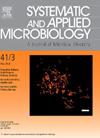原核生物系统学环境基因组学实用指南
IF 4.2
2区 生物学
Q2 BIOTECHNOLOGY & APPLIED MICROBIOLOGY
引用次数: 0
摘要
环境霰弹枪测序可以深入了解微生物群落概况,功能能力,以及代表微生物组个体成员的宏基因组组装基因组(MAGs)的恢复。同样,通过微流体和测序技术的进步,单细胞扩增基因组(sag)的组装也成为可能。这些领域已经经历了数据量的巨大增长,分析工具的不断发展,最终,恢复的基因组数量缺乏有效的名称。由于大多数微生物是不可培养的,因此与传统的命名要求不兼容,序列数据库中充满了质量不一的基因组,没有标准化的命名法,阻碍了交流和数据的可用性。为了克服这些限制,最近推出的序列数据描述原核生物命名代码(SeqCode)包括基因组质量标准和基于DNA序列有效命名未培养原核生物的命名标准。宏基因组学和系统学对新用户来说可能是一个压倒性的领域,所以我们在这里提供一个指南来帮助澄清主题并指出特殊的注意事项。这些主题包括宏基因组管道,基因组质量评估标准,其次是分类和性状预测工具。接下来,我们将介绍源元数据、丰度和占用测量方法,最后介绍命名法和名称注册。社区努力生成具有完整描述和有效名称的高质量原核基因组对环境基因组数据的未来可用性和交流至关重要。本文章由计算机程序翻译,如有差异,请以英文原文为准。
A practical guide on environmental genomics for prokaryotic systematics
Environmental shotgun sequencing can provide great insight into microbial community profiles, functional capabilities, and the recovery of metagenome-assembled genomes (MAGs) which represent individual microbiome members. Similarly, assembly of single-cell amplified genomes (SAGs) is possible through advances in microfluidics and sequencing techniques. These fields have experienced tremendous growth in the amount of data produced, the ongoing development of analytical tools, and ultimately, the number of genomes recovered lacking valid names. As most microbes are uncultivable and therefore incompatible with traditional naming requirements, sequence databases are filled with genomes of varying quality and without standardized nomenclature, hindering communication and data usability. Overcoming these limitations, the recently introduced Code of Nomenclature of Prokaryotes Described from Sequence Data (SeqCode) includes genome quality criteria and nomenclature standards to validly name uncultivated prokaryotes based on DNA sequence. Metagenomics and systematics can be overwhelming fields for new users, so here we provide a guide to help clarify topics and point out special considerations. These topics include metagenomic pipelines, genome quality assessment criteria, followed by taxonomy and trait prediction tools. Next, we cover source metadata, methods for abundance and occupancy measurement, and lastly, nomenclature and name registration. Community efforts to generate high-quality prokaryotic genomes with thorough descriptions and valid names are crucial for the future usability and communication of environmental genomic data.
求助全文
通过发布文献求助,成功后即可免费获取论文全文。
去求助
来源期刊

Systematic and applied microbiology
生物-生物工程与应用微生物
CiteScore
7.50
自引率
5.90%
发文量
57
审稿时长
22 days
期刊介绍:
Systematic and Applied Microbiology deals with various aspects of microbial diversity and systematics of prokaryotes. It focuses on Bacteria and Archaea; eukaryotic microorganisms will only be considered in rare cases. The journal perceives a broad understanding of microbial diversity and encourages the submission of manuscripts from the following branches of microbiology:
 求助内容:
求助内容: 应助结果提醒方式:
应助结果提醒方式:


